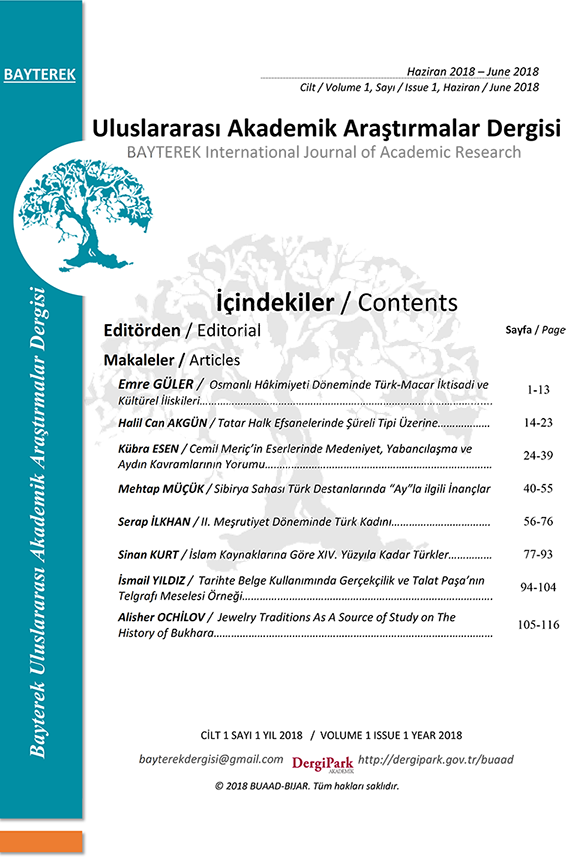Er Töştük (Töstik) Anlatıları Bağlamında Tokpay-Bay ve Karaglış Masallarının Mukayeseli İncelemesi
destan, masal, Er-Töştük, Tokpay-Bay, Karaglış
Comparative Analysis of Tokpay-Bay and Karaglıš Tales in the Context of Er Töštük (Töstı̇k) Narratives
epic, fairytale, Er-Töştük, Tokpay-Bay, Karaglış,
___
- Arvas, A. (2022). Türk Dünyası Epik Destanlarında Olağanüstü "Yedi Silah". Milli Folklor, 17(134), s. 5 - 16.
- Bal, G., ve Kayabaşı, O. A. (2019). Sibirya Sahası Türk Destanlarında Kadının Yeri ve Bu Bağlamda Eski Türklerin Kadına Bakışı. Türkiyat Mecmuası - Journal of Turkology, 29(2), s. 419-434.
- Boratav, P. N. (2005). Masal Ve Destansı Anlatım. (Ç. M. Taşlıova, Dü.) Erdem(42), s. 31-58. https://doi.org/10.32704/erdem.2005.42.031
- Boratav, P. N., & Bazin, L. (1989). Aventures Merveilleuses Sous Terre Et Ailleurs De Er-Töshtük, Le Géant Des Steppes - Épopée Du Cycle De Manas -. Gallimard/Unesco.
- Buzina, S. V., & Smotrova, A. V. (2022). Otritsatelnıye Jenskiye Obrazı v Volşebnıh Skazkah Narodov Rossii. Hudojestvennıy Tekst i Kultura: Janrovıye Strategii, Motivnaya Struktura [Elektronnıy Resurs] : Materialı XIV Mejdunar. Nauç. konf. (28 – 29 okt. 2021 g. Vladimir) (s. 53-68). Vladimir: Izd-vo VlGU. https://dspace.www1.vlsu.ru/bitstream/123456789/10668/1/02498.pdf adresinden alındı. Erişim tarihi 02.04.2023.
- Çahvarovna, F. G., Vladimirovna, P. M., & Nikolayevna, Y. Y. (2019). Jenskiye Demoniçeskiye Personaji v Mifah i Folklore Narodov Zapadnoy Sibiri: Genezis, Funktsii, Atributika. Nauçnıy Dialog(12), 198-208.
- Çeribaş, M. (2013). Kırgız Türklerinin Mitlerinde ve Efsanelerinde Olağanüstü Varlıklar, Bu Varlıklara Dair Anlatmalar ve İnanmalar. B. Gül, F. Ağca, & F. Gökçe (Dü) içinde, Bengü Bitig, Dursun Yıldırım Armağanı (s. 173-200). Ankara: Türkbilig.
- Çeribaş, M. (2013). Oğuz-Kıpçak Ortak Destancılık Geleneği Bağlamında Er Töştük ve Dede Korkut Destanları. 11. Uluslararası Türk Dünyası Sosyal Bilimler Kongresi 10-16 Haziran 2013 / Celalabat – KIRGIZİSTAN – Türk Dünyasının Vizyon Arayışı Kongre Bildirileri (s. 709-718). İstanbul: Türk Dünyası Araştırmaları Vakfı.
- Gankin, V. D. (2018). Mariyskiye İmena i Familii. Gorodok. https://bibl-krasnoufimsk.ru/index.php/kraevedy/materialy-v-gankina/proiskhozhdenie-familij/1162-marijskie-imena-i-familii.html adresinden alındı
- Hallaç, A. T. (2022). Türk Dünyasında Alkarısı. Yıldırım Beyazıt Üniversitesi, Sosyal Bilimler Enstitüsü, Türk Dili ve Edebiyatı Anabilim Dalı, Yayımlanmamış Doktora Tezi.
- Hisamitdinova, F. G. (2010). Mifologiçeskiy Slovar Başkirskogo Yazıka. Moskva: Nauka.
- Karadavut, Z. (1996). Köroğlu`nun Zuhuru Kolu Üzerine Mukayeseli bir Araştırma (İnceleme-Metinler). Konya: Selçuk Üniversitesi / Sosyal Bilimler Enstitüsü / Türk Dili ve Edebiyatı Ana Bilim Dalı / Halk Edebiyatı Bilim Dalı / Doktora Tezi.
- Kayabaşı, O. A. (2016). Türk Destanlarında Baba-Oğul Çatışması. Turkish Studies, 11(4), s. 505-516.
- Malışeva, M. P., ve V. S. Poznanskiy. 1990. «Etnografiçeskiye Materialı Çingisa Valihanova.» İzvestiya AN KazSSR. Seriya Obşçestvennaya.
- https://www.vostlit.info/Texts/Dokumenty/M.Asien/XIX/1860-1880/Valichanov_Cingiz/text1.htm
- Mugallimoviç, M. K., & Zakirova, I. G. (2019). Obraz Staruhi Ubırlı v Tatarskih Volşebnıh Skazkah. Gramota, 12(9), 81-84.
- Mullen, P. B. (2018). Halk İnancı ve Efsane İlişkisi. folklor/edebiyat, 24(96), 211-220. https://doi.org/10.22559/folklor.397
- Potanin, G. N. (1916). Kazak - Kirgizskiya i Altayskiya Pre Daniya, Legendı i Skazki. Jivaya Starina, 25(II-III), 47-198.
- Propp, V. Y. (2000). İstoriçeskiye Korni Volşebnoy Skazki. Moskva: Labirint.
- Pustyakov, A. L. (2017). Adaptatsiya Russkih Hristianskih İmen v Mariyskom Yazıke. Voprosı Onomastiki, 14(3), s. 128-167. https://doi.org/10.15826/vopr_onom.2017.14.3.027
- Radlov, V. V. (1872). Obraztsı Narodnoy Literaturı Tyurkskih Plemen, Jivuşçih v Yujnoy Sibiri i Djungarskoy Stepi, Sobrannıye V. V. Radlovım (Cilt 4. Nareçiya Barabintsev, Tarskih, Tobolskihi Tyumenskih Tatar). Sankt-Peterburg: Imperat. Akad. nauk.
- Radlov, V. V. (1885). Obraztsı Narodnoy Literaturı Severnıh Tyurkskih Plemen (Cilt 5. Nareçiye Dikokamennıh Kirgizov). Sankt-Peterburg: Tip. Imperat. Akad. nauk.
- Taube, E. (1993). Die altaituwinische Version des Er-Töştük-Stoffes im Verhaltnis zu den Versionen anderer Türkvolker. J. P. Laut, & K. Röhrborn (Dü.), Sprach- und Kulturkontakte der türkischen Völker, Materalien der zweiten Deutschen Turkologen-Konferenz Rauischholzhausen, 13-16 Juli 1990 içinde (s. 193-199). Wiesbaden: Harrassowitz Verlag.
- Taube, E. (1994). Skazki i Predaniya Altayskih Tuvintsev. Moskva: Vostoçnaya Literatura.
- Temur, N. (2018). Er Töştük Destanı Cusup Mamay Varyantı (İnceleme-Metin). Ankara: Grafiker Yayınları.
- Türkmen, F. (1995). Manas Destanı Üzerine İncelemeler (Çeviriler-1). Ankara: Türk Dil Kurumu.
- Vasiliyev, A. V. (1898). Obraztsı Kirgizskoy Narodnoy Slovesnosti. Vışusk Perviy. Kirgizskiya Skazki. Orenburg: Tipo-litografiya B. A. Breslina.
- Yeşildal, Ü. Y. (2015a). Er Töştük Destanı (İnceleme-Metin). Ankara: Gazi Üniversitesi Sosyal Bilimler Enstitüsü Türk Dili ve Edebiyatı Ana Bilim Dalı Türk Halk Edebiyatı Bilim Dalı Yayımlanmamış Doktora Tezi.
- Yeşildal, Ü. Y. (2015b). Er Töştük anlatısının Kırgız ahasına ait Nesir Varyantları. 21. Yüzyılda Eğitim ve Toplum, 4(11), s. 81-113.
- Yıldırım, S. (2014). G. N. Potanin’in Kazak Türkleri Arasında Derlemiş Olduğu Er Töstik (Er Töştük) Anlatıları Hakkında. 21. Yüzyılda Eğitim ve Toplum, 3(9), 75-102.
- Yıldırım, S., & Hallaç, A. T. (2022). Altay Tıvaları ve Er Töştük Anlatısının Altay Tıva Varyantı: Bay Nazar. Motif Akademi Halkbilimi Dergisi, 15(37), s. 1-21. https://doi.org/10.12981/mahder.1065426
- Zakirova, I. G. (2017). Tatarskaya Bogatyrskaya Skazka. Gramota, 9(75), 31-34.
- Yayın Aralığı: Yılda 2 Sayı
- Başlangıç: 2018
- Yayıncı: Onur Alp KAYABAŞI
Öğrencilerde İstenmeyen Davranışlar ve Bu Davranışları Engelleme Yaklaşımları
Esma DUYMAZ, Turgut AKDOĞAN, Emrah TUNCER
Tarımla İlgili İnanışlar ve Günümüze Yansımaları (Arpa, Buğday, Bulgur)
Yabancılara Türkçe Öğretiminde Öğrencilerin Sözlük Kullanma Tercihlerinin İncelenmesi
Öğretmenlik Uygulaması Dersine İlişkin Algıların Öğretmenlik Mesleğine Bağlılık Düzeyi ile İlişkisi
Okul Müdürlerinin Öğretmen Görüşlerine Göre Dağıtımcı Liderliği Gerçekleştirme Düzeyleri
ÖĞRETMEN GÖRÜŞLERİNE GÖRE OKUL YÖNETİCİLERİNİN YETERLİLİKLERİ: META-SENTEZ ÇALIŞMASI
Emel SEYHAN ÇİFTÇİ, Ersoy AKDAĞ, Önder ULU, Emre ADA, Nurcihan DOĞAN
Ortaokul Öğrencilerine Yönelik Bilişim Teknolojileri Öz-Yeterlik Algısı
Er Töştük (Töstik) Anlatıları Bağlamında Tokpay-Bay ve Karaglış Masallarının Mukayeseli İncelemesi
